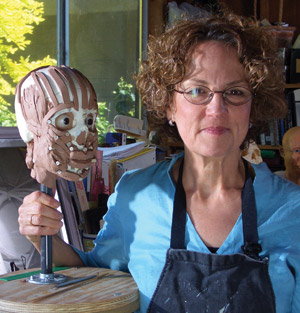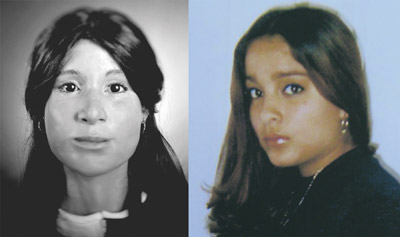
Gloria Nusse’s professional direction changed as she stood in a labyrinthine Wichita State registration line in 1976: “It was at the end of the day and I had been in line for about six hours,” she says. “I needed one more class and it needed to be in biology.”
The ceramics junior ended up in Vic Eichler’s comparative anatomy course, which, as an art student, she was allowed to take pass/fail.
“I just had this turnaround moment in that class,” Nusse says. “I realized I love research, and I love the natural world and using my technical skills as well as my artistic skills.”
An animal lover with a background in life drawing, she was fascinated by the similarities and differences in human and animal musculature and bone structure.
And her textbook demonstrated a clear relationship between science and the arts. “I could see that artists were drawing the pictures used in the textbooks. The work of many artists I had already been studying like Albrecht Durer, Leonardo Da Vinci, Rosa Bonheur, Fuentes and many others began to take on new significance. I knew that when I left the university I wanted to pursue a career combining art and science.” Nusse has indeed built a career doing the work she dreamed of, illustrating textbooks and creating models and sculptures for museum displays.
Perhaps her most compelling combination of science and art is her work on cold cases — police investigations that have gone unsolved for years and that sometimes have unidentified victims.
When missing persons bulletins and artist’s sketches don’t work, investigators may contact someone like Nusse, as the Alameda, Calif., Sheriff’s Department’s cold case unit did two years ago. In an investigation covered by the CBS newsmagazine "48 Hours," the unit exhumed the body of a teenage girl whose murdered, partly decomposed body was found on May 1, 2003 in the usually peaceful Castro Valley.
After the exhumation, an anthropologist studied the girl’s bones, a dentist took X-rays of her jaw, and Nusse made a cast of her skull. During the following six weeks, Nusse worked with the cast in her studio while a news crew filmed. She used a process sometimes called facial approximation, using clay and very specific measurements to re-create the girl’s face. “It’s all based on averages, so it’s not an absolute,” she explains. “But if a family member is missing and you see a facial reconstruction, it might trigger something.
“It’s fascinating if you think about how we recognize each other, even if it’s a difference between one or two millimeters. Humans are very acute visually. The skeletal structure is unique, and when you begin to layer on muscle and skin you begin to have something that is potentially identifiable.”
When she finished the facial reconstruction of the Castro Valley Jane Doe, the police held a press conference to unveil the bust. Five months later, the "48 Hours" story aired. Finally, almost a year and a half after Nusse completed her sculpture, the body was identified as belonging to 16-year old Yesenia Nungaray Becerra, who left her home in Yahualica, Mexico, on her 16th birthday to seek a better life in the United States.

Gloria Nusse’s facial reconstruction of an
unidentified murder victim eventually led to the
identification of 16-year-old Yesenia Nungaray
Becerra. “To me, it’s the ultimate combination of
art and science,” says Nusse about her work in
forensic sculpture.
The case of Nungaray Becerra is one of 10 or 12, Nusse estimates, she has worked on over the past seven years. Three of her subjects have been identified, and there have been leads on one or two others.
“Yesinia’s case is actually relatively recent in this field,” she says. “Some of the cases I work on are ten, fifteen, twenty years old. Obviously, the older the case, the less chance there is of getting a positive identification. But if (a skeleton) is all you have to work with, it’s worth the chance.”
But television programs like "C.S.I." don’t exactly reflect reality: “It’s not a fast process, like on TV,” Nusse notes.
Nusse considers forensic sculpture the culmination of her studies and interests, but she made a few stops along the way before she sculpted her first unidentified person. She charts the beginning of her career to her Wichita State education, where she developed the artistic skills she still uses today.
“I’m very proud of my degree from WSU,” says Nusse, who studied with ceramics head Don Schule. “I often talk about the great program we had there. We had to learn a lot of practical, technical skills like mold-making, and there was a strong emphasis on life drawing.”
And of course Nusse discovered her passion for science in the classroom of Vic Eichler, with whom she still exchanges Christmas cards. After her first exposure to anatomy, she audited other biology classes and got her first jobs in her desired field when she illustrated Eichler’s book about embryology and Dr. Langley’s lab manual for invertebrate biology.
After her graduation in 1978, Nusse moved to California where she worked for theaters –– “building armor and masks and that sort of thing” –– before landing a job teaching for the California Academy of Sciences in 1981. Three years later, she began working on museum pieces. Her work has been on display at the Smithsonian, Yosemite National Park and museums in Mexico City and Germany, among others. In 2000, she traveled to Arizona to take a class from two of the world’s most prominent forensic reconstruction artists. She took more classes, began practicing and now teaches seminars herself.
A few years ago Nusse decided to continue her formal studies as a master’s degree student in anthropology at San Francisco State University, where she studies osteology and teaches a lab class in gross anatomy. She’ll graduate in December.
Nusse doesn’t plan to stop juggling anytime soon. She still gets commissions from museums and organizations such as the National Parks Service. Even if she wanted to focus on forensic reconstruction full-time, there just isn’t enough demand, even if there are only 12 to 25 forensic sculptors in the United States, as she estimates.
“You can’t make a living at it –– it’s not done a lot,” Nusse says. “Much of the time, agencies don’t have much money to spend, because these are cold cases. But it’s fulfilling, and to me it’s the ultimate combination of art and science.”





